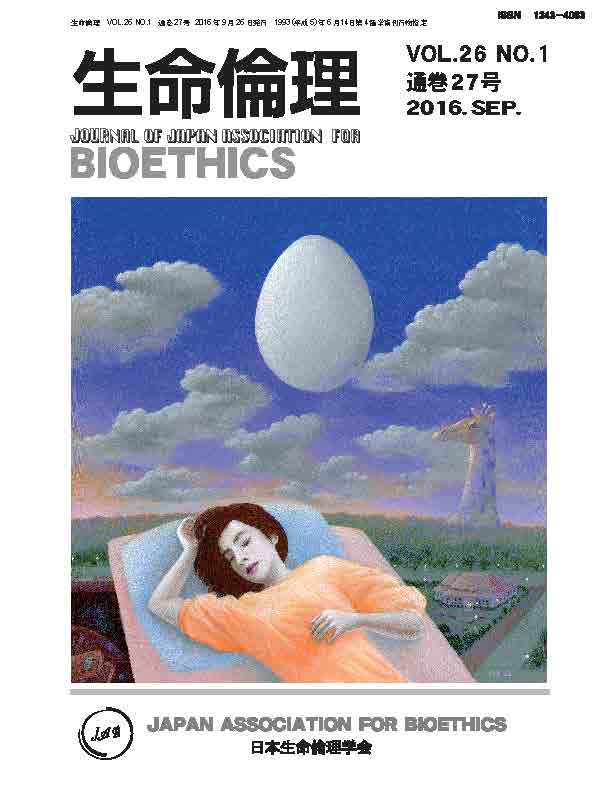Volume 26, Issue 1
BIOETHICS
Displaying 1-25 of 25 articles from this issue
- |<
- <
- 1
- >
- >|
Contents
-
2016Volume 26Issue 1 Pages 1-2
Published: 2016
Released on J-STAGE: September 30, 2017
Download PDF (186K)
Foreword
-
2016Volume 26Issue 1 Pages 3
Published: 2016
Released on J-STAGE: September 30, 2017
Download PDF (222K)
Articles
-
2016Volume 26Issue 1 Pages 4-14
Published: 2016
Released on J-STAGE: September 30, 2017
Download PDF (574K) -
2016Volume 26Issue 1 Pages 15-25
Published: 2016
Released on J-STAGE: September 30, 2017
Download PDF (667K) -
2016Volume 26Issue 1 Pages 26-34
Published: 2016
Released on J-STAGE: September 30, 2017
Download PDF (408K) -
2016Volume 26Issue 1 Pages 35-45
Published: 2016
Released on J-STAGE: September 30, 2017
Download PDF (1755K) -
2016Volume 26Issue 1 Pages 46-53
Published: 2016
Released on J-STAGE: September 30, 2017
Download PDF (436K)
Reports
-
2016Volume 26Issue 1 Pages 54-62
Published: 2016
Released on J-STAGE: September 30, 2017
Download PDF (467K) -
2016Volume 26Issue 1 Pages 63-71
Published: 2016
Released on J-STAGE: September 30, 2017
Download PDF (431K) -
2016Volume 26Issue 1 Pages 72-80
Published: 2016
Released on J-STAGE: September 30, 2017
Download PDF (403K) -
2016Volume 26Issue 1 Pages 81-89
Published: 2016
Released on J-STAGE: September 30, 2017
Download PDF (414K) -
2016Volume 26Issue 1 Pages 90-99
Published: 2016
Released on J-STAGE: September 30, 2017
Download PDF (575K) -
2016Volume 26Issue 1 Pages 100-106
Published: 2016
Released on J-STAGE: September 30, 2017
Download PDF (363K) -
2016Volume 26Issue 1 Pages 107-114
Published: 2016
Released on J-STAGE: September 30, 2017
Download PDF (434K) -
2016Volume 26Issue 1 Pages 115-123
Published: 2016
Released on J-STAGE: September 30, 2017
Download PDF (482K) -
2016Volume 26Issue 1 Pages 124-133
Published: 2016
Released on J-STAGE: September 30, 2017
Download PDF (421K) -
2016Volume 26Issue 1 Pages 133-141
Published: 2016
Released on J-STAGE: September 30, 2017
Download PDF (396K) -
2016Volume 26Issue 1 Pages 142-149
Published: 2016
Released on J-STAGE: September 30, 2017
Download PDF (392K) -
2016Volume 26Issue 1 Pages 150-158
Published: 2016
Released on J-STAGE: September 30, 2017
Download PDF (434K) -
2016Volume 26Issue 1 Pages 159-168
Published: 2016
Released on J-STAGE: September 30, 2017
Download PDF (1196K) -
2016Volume 26Issue 1 Pages 169-177
Published: 2016
Released on J-STAGE: September 30, 2017
Download PDF (387K) -
2016Volume 26Issue 1 Pages 178-187
Published: 2016
Released on J-STAGE: September 30, 2017
Download PDF (384K)
Program of the 27th Annnual Meeting
-
2016Volume 26Issue 1 Pages 189-196
Published: 2016
Released on J-STAGE: September 30, 2017
Download PDF (361K)
-
2016Volume 26Issue 1 Pages 197
Published: 2016
Released on J-STAGE: September 30, 2017
Download PDF (110K)
-
2016Volume 26Issue 1 Pages 198
Published: 2016
Released on J-STAGE: September 30, 2017
Download PDF (152K)
- |<
- <
- 1
- >
- >|
